Related Research Articles

The Krugerrand is a South African coin, first minted on 3 July 1967 to help market South African gold and produced by Rand Refinery and the South African Mint. The name is a compound of Paul Kruger, the former President of the South African Republic, and rand, the South African unit of currency. On the reverse side of the Krugerrand is a pronking springbok, South Africa's national animal.

Palladium is a chemical element with the symbol Pd and atomic number 46. It is a rare and lustrous silvery-white metal discovered in 1803 by the English chemist William Hyde Wollaston. He named it after the asteroid Pallas, which was itself named after the epithet of the Greek goddess Athena, acquired by her when she slew Pallas. Palladium, platinum, rhodium, ruthenium, iridium and osmium form a group of elements referred to as the platinum group metals (PGMs). They have similar chemical properties, but palladium has the lowest melting point and is the least dense of them.

Precious metals are rare, naturally occurring metallic chemical elements of high economic value. Chemically, the precious metals tend to be less reactive than most elements. They are usually ductile and have a high lustre. Historically, precious metals were important as currency but are now regarded mainly as investment and industrial commodities. Gold, silver, platinum, and palladium each have an ISO 4217 currency code.

The Royal Canadian Mint is the mint of Canada and a Crown corporation, operating under the Royal Canadian Mint Act. The shares of the Mint are held in trust for the Crown in right of Canada.

The American Gold Eagle is an official gold bullion coin of the United States. Authorized under the Gold Bullion Coin Act of 1985, it was first released by the United States Mint in 1986. Because the term "eagle" also is the official United States designation for pre-1933 ten dollars gold coins, the weight of the bullion coin is typically used when describing American Gold Eagles to avoid confusion. This is particularly true with the 1/4-oz American Gold Eagle, which has a marked face value of ten dollars.
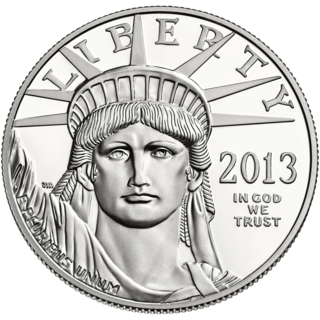
The American Platinum Eagle is the official platinum bullion coin of the United States. In 1995, Director of the United States Mint Philip N. Diehl, American Numismatic Association President David L. Ganz, and Platinum Guild International Executive Director Jacques Luben began the legislative process of creating the Platinum Eagle. After over two years of work, the 99.95% fine platinum coins were released by the United States Mint in 1⁄10, 1⁄4, 1⁄2 and 1 troy oz denominations. In late 2008, the fractional denominations were discontinued, leaving only the one ounce denomination. The Platinum Eagle is authorized by the United States Congress, and is backed by the United States Mint for weight, content, and purity.

The Chinese Silver Panda is a series of silver bullion coins issued by the People's Republic of China. The design of the panda is changed every year and minted in different sizes and denominations, ranging from 0.5 troy oz. to 1 kilogram. Starting in 2016, Pandas switched to metric sizes. The 1 troy ounce coin was reduced to 30 grams, while the 5 troy ounce coin was reduced to 150 grams. There is also a Gold Panda series issued featuring the same designs as the Silver Panda coins.
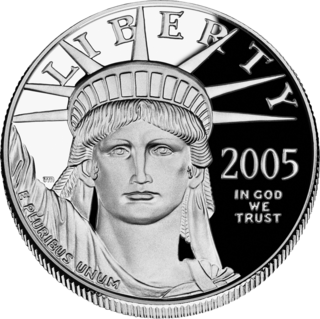
Platinum coins are a form of currency. Platinum has an international currency symbol under ISO 4217 of XPT. The issues of legitimate platinum coins were initiated by Spain in Spanish-colonized America in the 18th century and continued by the Russian Empire in the 19th century. As a form of currency, these coins proved to be impractical: platinum resembles many less expensive metals, and, unlike the more malleable and ductile silver and gold, it is very difficult to work. Several commemorative coin sets have been issued starting from 1978 and became popular among coin collectors. The major platinum bullion coins include the American Platinum Eagle, the Canadian Platinum Maple Leaf, the Australian Platinum Koala, the Isle of Man Noble, the Chinese Platinum Panda, the Austrian Vienna Philharmonic and several series by the Soviet Union and later by the Russian Federation.
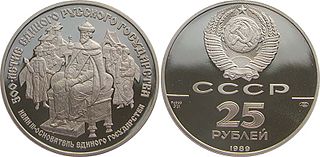
Palladium coins are a form of coinage made out of the rare silver-white transition metal palladium. Palladium is assigned the code XPD by ISO 4217. The first palladium coins were produced in 1966.
In 1981, China began minting coins to commemorate the Chinese New Year. The Chinese lunar series consist of gold, silver, and platinum coins in a variety of sizes, denominations, and shapes. The reverse of each coin depicts the zodiac animal for the corresponding year of issue, while the obverse features an historical building or other notable cultural image.
The Canadian Platinum Maple Leaf is the official bullion platinum coin of Canada. First issued by the Royal Canadian Mint in 1988, it was available until 2002 in five different denominations, all of which are marked as containing .9995 pure platinum. The bullion coin was partly reintroduced in 2009 in the form of the 1 troy ounce denomination in .9999 purity, featuring a new portrait of Queen Elizabeth II on the obverse. The coins have legal tender status in Canada, but as is often the case with bullion coins, the face values of these coins is lower than the market price of the material they are made from.
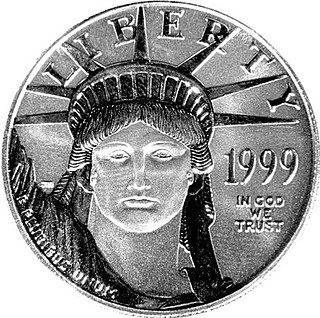
Platinum as an investment has a much shorter history in the financial sector than gold or silver, which were known to ancient civilizations. Experts posit that platinum is about 15–20 times scarcer than gold, on the basis of annual mine production. Since 2014, platinum rates have fallen significantly lower than gold rates. More than 75% of global platinum is mined in South Africa.
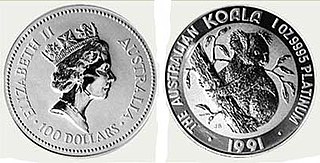
The Platinum Koala is an Australian platinum bullion coin minted by the Perth Mint between 1988 and 2000. The Platinum Koala is notionally legal tender, that is a legal means of payment.

The Chinese Gold Panda is a series of gold bullion coins issued by the People's Republic of China. The Official Mint of the People's Republic of China introduced the panda gold bullion coins in 1982. The panda design changes every year and the Gold Panda coins come in different sizes and denominations, ranging from 1⁄20 to 1 troy ounce.

A gold coin is a coin that is made mostly or entirely of gold. Most gold coins minted since 1800 are 90–92% gold, while most of today's gold bullion coins are pure gold, such as the Britannia, Canadian Maple Leaf, and American Buffalo. Alloyed gold coins, like the American Gold Eagle and South African Krugerrand, are typically 91.7% gold by weight, with the remainder being silver and copper.
A gold IRA or precious metals IRA is an Individual Retirement Account in which physical gold or other approved precious metals are held in custody for the benefit of the IRA account owner. It functions the same as a regular IRA, only instead of holding paper assets, it holds physical bullion coins or bars. Precious metals IRAs are usually self-directed IRAs, a type of IRA where the custodian allows more diverse investments to be held in the account.
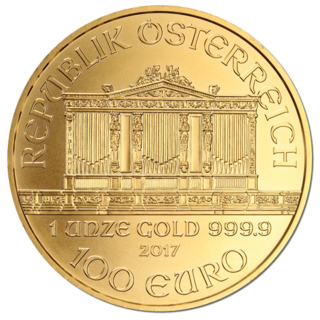
The Vienna Philharmonic, often shortened to Philharmonic, is a bullion coin of gold, silver, or platinum produced by the Austrian Mint. The coin is named for the Vienna Philharmonic orchestra, which inspired the design of both sides. It was introduced in 1989 as a one-troy ounce (ozt), gold coin with a face value of 2,000 Austrian schillings. It is generally one of the world's best selling bullion coins. In 2002, with the adoption of the euro currency, the nominal value of the one-ounce coin was changed to 100 euros. In 2008, the Mint introduced a one-ounce silver version of the coin with a nominal value of 1.50 euros. The silver coin is also one of the top selling bullion coins, ranked third in 2013. In 2016, the mint introduced a one ounce platinum coin with a face value of 100 euros.
PAMP SA is an independently operated precious metals refining and fabricating company and member of the MKS Group. It was established in 1977 in Ticino, Switzerland

The American Palladium Eagle is the official palladium bullion coin of the United States. Each coin has a face value of $25 and contains 99.95% fine palladium. It was authorized by the American Eagle Palladium Bullion Coin Act of 2010 which became Public Law 111-303 passed during the 111th United States Congress. The Palladium Eagle uses Adolph Weinman's obverse design on the Mercury dime, Liberty wearing a winged hat, while its reverse design is based on Weinman's 1907 American Institute of Architects (AIA) medal design.
References
- ↑ Images of these coins do not fall under a Wikipedia-compatible license, but can be found at numismatic sites.
- ↑ The 2002 issue is dedicated to the 20th anniversary of the printing of the Chinese Panda Gold Coin.
- 1 2 "Coins of China. Platinum Panda" . Retrieved 12 September 2009.
- ↑ "Platinum and Palladium Charts. London Platinum and Palladium Market (LPPM)". Archived from the original on 10 August 2011. Retrieved 13 September 2010.